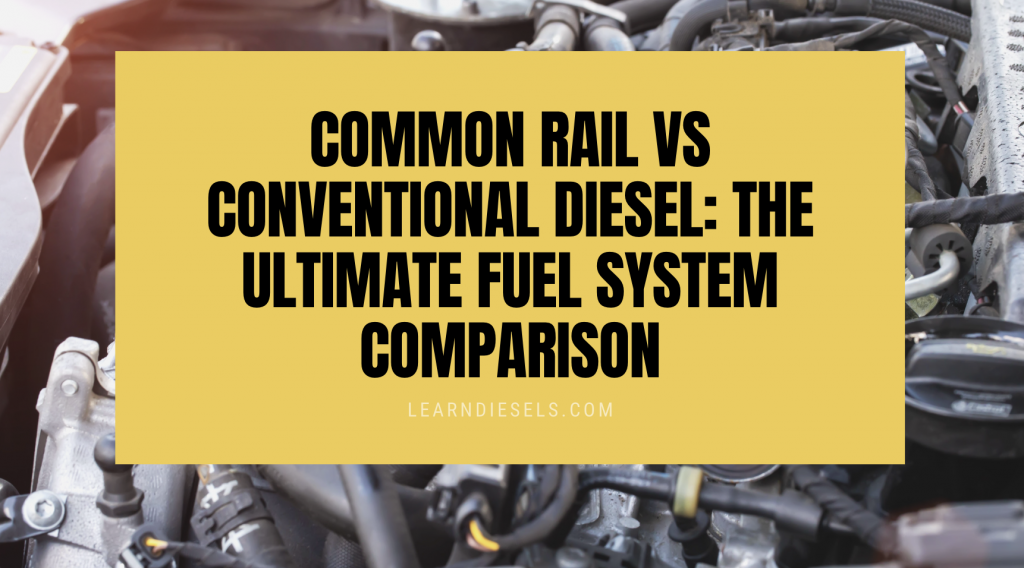Are you wondering what sets the common rail diesel fuel system apart from the conventional or direct one? Look no further! In this article, we’ll compare and contrast the two systems, discussing their characteristics, advantages, and differences.

The main difference between common rail and direct injection diesel fuel systems lies in their method of fuel delivery. Conventional diesel fuel systems use a mechanical pump to deliver fuel to the engine, while common rail systems use a high-pressure pump to deliver fuel directly to the injectors.
The main characteristic of common rail systems is their ability to deliver fuel at a much higher pressure, providing more precise and consistent injections.
The advantage of the common rail system is its improved fuel efficiency, lower emissions, and better overall performance compared to the conventional diesel fuel injection system. Common rail systems also allow for multiple injections per engine cycle, further improving fuel efficiency and reducing emissions.
Unit injection systems, on the other hand, differ from common rail systems in that they incorporate the high-pressure pump and injectors into a single unit, rather than having a separate high-pressure pump. This results in a compact and simple design but also limits the system’s ability to deliver fuel at the same high pressures as common rail systems.
Still awake? Ready to dive deeper into the world of diesel fuel systems? Keep reading to learn more about the specific benefits and drawbacks of each system.
Common Rail Diesel Fuel System: A Closer Look
The common rail diesel fuel system is known for its improved fuel efficiency and reduced emissions, thanks to its ability to deliver fuel at high pressures. The system consists of a high-pressure pump, which delivers fuel to a common rail, a shared fuel supply line that leads to individual injectors. This allows the system to deliver fuel at a consistent and controlled pressure, resulting in more precise injections and improved fuel efficiency.
Additionally, common rail systems allow for multiple injections per engine cycle, further improving fuel efficiency and reducing emissions. These systems are also capable of delivering a wider range of injection pressures, giving them more flexibility and control over the fuel delivery process.
Overall, the common rail diesel fuel system offers improved performance, reduced emissions, and improved fuel efficiency compared to conventional diesel fuel systems.
Direct Injection Diesel Fuel System: The Classic Option
In contrast to the common rail diesel fuel system, the Direct injection fuel system uses a mechanical pump to deliver fuel to the engine. The mechanical pump is responsible for generating the pressure required to inject fuel into the engine, but its performance is limited compared to the high-pressure pump in common rail systems.
Despite its limitations, the conventional diesel fuel system is still a reliable and cost-effective option for many diesel engines. It is simpler in design and often more affordable than common rail systems, making it a popular choice for older diesel engines and applications where cost is a concern.
Unit Injection System: The Middle Ground
If you’re familiar with diesel engines, you may have heard of the unit injection system, or UIS. It’s often seen as the middle ground between conventional diesel fuel systems and common rail systems. So, what exactly is a unit injection system and how does it differ from the others?
A unit injection system is similar to a direct injection diesel fuel system in that it uses individual fuel injectors for each cylinder, just like in a conventional diesel fuel system. However, unlike a conventional diesel fuel system, a unit injection system has a high-pressure pump located within the injector itself. This pump allows for more precise fuel control and improved engine performance compared to a conventional diesel fuel system.
One of the biggest advantages of a unit injection system is that it provides better cold start performance compared to a conventional diesel fuel system. This is because the high-pressure pump within the injector is able to generate enough pressure to start the engine, even in cold weather conditions.
Another advantage of a unit injection system is that it allows for smoother operation compared to a conventional diesel fuel system. This is because the high-pressure pump within the injector can control the fuel flow more precisely, reducing the amount of fuel that is wasted.
Overall, the unit injection system is a great choice for those who are looking for a diesel fuel system that provides improved performance and better cold start capabilities compared to a conventional diesel fuel system. It’s not as technologically advanced as a common rail system, but it provides a good balance of performance and cost-effectiveness.
Summing up
In conclusion, whether you choose a common rail, conventional diesel, or unit injection system, the most important thing is to make sure you’re working with a knowledgeable mechanic who can help keep your engine running smoothly. Whether you’re a seasoned diesel mechanic or just starting out, understanding the basics of these systems will give you a solid foundation for making informed decisions about your diesel engine.
